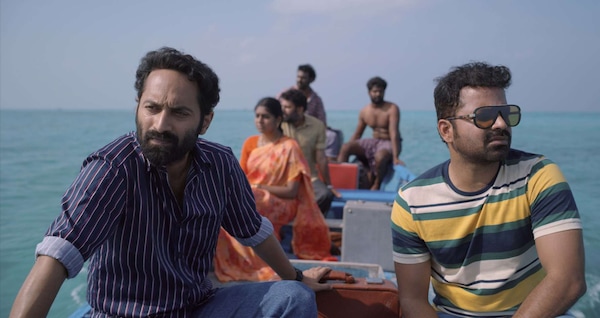Malik movie review: Fahadh’s coastal drama is relevant in an age of divisive politics and compliancy
Malik, unlike Mahesh Narayanan’s previous two directorials C U Soon and Take Off, is expansive in its story and setting as it focuses primarily on the evolution of a coastal community over a span of half a century

Fahadh Faasil in a still from Malik
Last Updated: 11.28 AM, Jul 15, 2021
There is a fury in Sulaiman Ali’s (Fahadh Faasil) eyes every time someone hints at a rift among his people in the name of religion. You first see it when his best friend David (Vinay Forrt) raises an argument about how people of his community in Edavathura is dragged into a mess because of those in Ramadapally. Three decades later, when Sulaiman is confronted by David’s son, who is sent to kill him, it’s this mention of a divide between his people again that enrages him the most. Director Mahesh Narayanan’s Malik for most parts channels this resistance of Sulaiman – from his early 20s to late 50s – against those trying to displace the minority communities of the coastal villages of Edavathura and Ramadapally for political gains and corporate greed.
Malik, unlike Mahesh’s previous two directorials C U Soon and Take Off, is expansive in its story and setting even though it focuses primarily on the evolution of a coastal community over a span of half a century. The movie begins with an extensive single shot on the eve Sulaiman heads to the Haj pilgrimage. Just before boarding his flight, Sulaiman is booked under the TADA Act and remanded under police custody. However, there is a bigger ploy at work, with the State and the police force colluding to kill Sulaiman, who is the sole reason why the people of his coastal village are able to stave off the strategic attempts of the State to displace the community in the name of development. However, with the police unwilling to get their hands dirty, they manipulate Freddy, a youngster from Edavathura, to do their bidding. Through three separate conversations, Freddy gets a perspective of the life of the man he is tasked to kill.
The director-scriptwriter had previously cited how IV Sasi and T Damodaran’s films such as Ee Nadu and Iniyengilum have inspired him. While not a tribute, the movie takes a page from these classics that told engaging stories spanning decades. Even while Fahadh’s Sulaiman is its lead character, Mahesh has ensured that the roles played by Nimisha Sajayan, Vinay Forrt, Joju George, Dinesh Prabhakar, Jalaja, Chandhunadh G and others have equal importance to the story and its larger outcome that impact the community. In fact, after the first 15 minutes, Fahadh is not on screen for a good 20 minutes. This time is used to literally set up Sulaiman’s fate, an aspect that keeps the viewers hooked while the story travels back and forth and reveals his past and what made him the leader he is.
The movie, which is ostensibly inspired by true events in the coastal regions of Thiruvananthapuram, Kerala, reflects the strategies and rehabilitation schemes employed by the authorities, swayed by ulterior motives, over the years to displace the minority communities. The film mirrors how the community, after being ravaged by the sea and the lack of State support, are left with no choice but to abide – a sentiment echoed by David in his final scene. Apart from showing the impact of the manufactured communal riots, Mahesh also uses this element subtly by having the cops influence Sulaiman’s own nephew to kill him.
However, there are scenes in the drama that lack urgency that a movie with so many characters and side stories warranted. David’s perspective of the story is where this is most felt, and largely because it is predictable. Mahesh, while telling a pertinent tale, leaves it to the audience to read between the lines rather than drive certain points home. In a movie revolving around so many characters and perspectives, this method diffuses the core issues. With repeated watching, the audience will unravel more layers in Malik, but in the first watch, it does feel like Mahesh held back a bit and the movie quite doesn’t reach its peak potential.
Fahadh carries off the younger portions of Sulaiman with relative ease. While essaying the elder version of the character, he puts on an emotional performance when he breaks down to Freddy and even doubts himself when he repeats that, ‘Nobody in Ramadapally can do it’, to a cop. Nimisha shines again, this time in a role that goes through a wave of emotions, and her performance in her character Roslyn’s older portions make it all the more memorable. Vinay as Roslyn’s brother and Sulaiman’s friend David makes good use of the meaty part offered in the film and is brilliant in his scenes where he is used as a tool to stir up a riot. Joju George and Dileesh Pothan are equally good in their roles as a collector and politician, respectively.

Sanu John Varghese’s cinematography is one of its key highlights. An outstanding sequence where Sulaiman rushes outside the mosque’s compound while bullets are raining is pulsating, because of what’s awaiting Sulaiman and how Sanu steers the audience to it. Sushin Shyam’s music never feels intrusive and the songs too complement the mood of the drama. The score in the jail room scene when Sulaiman breaks down accentuates the whole sequence.
With Malik, if Mahesh was striving to make the audience aware of the struggles and riots of the minority communities in coastal regions, he has succeeded. While the film’s narrative takes its time to unfold, it is a triumph in telling an expansive story of an entire community through its chief.
Subscribe to our newsletter for top content, delivered fast.

